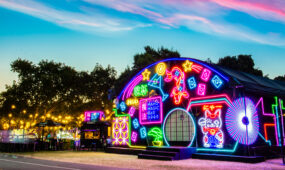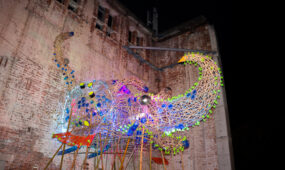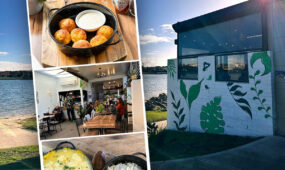Wine reviews: Bursting the cultural cringe bubble
Food & wine reviews
Tasting Australia’s social media posts seemed fixated on celebrating French Champagne, while a quintessential Australian sparkling style might have been more appropriate. Here’s some of that style’s intriguing history and four of the best for you to try.

Let’s do brunch. I’ll bring the wine.
To many minds, the thought of a morning bevvy will seem perverse. Problematic even. Pink elephants will come to mind, most likely.
Or not, if we’re talking bubbles. It seems that cracking a pre-noon bottle of Champagne or, as we have to call it here, Sparkling, is fully allowable. Encouraged even, if you’re the upwardly mobile, social brunching type.
If the health debate sparks a tickle of drinking confusion in you, fair call. And here’s another mixed message I’d like to share, one that has everything to do with cracking bottles of fizz.
SA recently indulged in our government-sponsored food and drinks event Tasting Australia. Skipping over the need for us to call time on its redundant title and rebadge it Tasting South Australia, given its public funding and state-regional focus, there was a disturbing number of partying moments captured in sanctioned social media posts where somehow the geography of it all went even further skewiff.
Lots of festival folks were Insta-captured celebrating the event by literally cracking bottles of fizz. No problem with that except that in virtually every one of the images it was French Champagne – not Australian Sparkling. Not South Australian Sparkling. So much for bang for your government buck.
The Champagne was joyously being sabraged – the top of the bottles, cork still intact, whacked off by the action of a specially designed sabre smacked against the neck and lip of the bottle to separate it in, let’s say, an effusive fashion, cork and collar remaining intact if successful, froth and bubble exploding to onlookers’ delight.
Cue cultural cringe.
There is, of course, some history to such an act. French history that is. It’s said that after many a victory by Napoleon’s cavalry across Europe, they would celebrate by opening Champagne bottles with their weapon of choice.
One story includes Madame Clicquot, who while still in her twenties had inherited her husband’s Champagne house. After entertaining Napoleon’s officers in her vineyard, the following morning they rode off with their complimentary bottle, opening them with their sabres to impress the young widow.
Such machismo may not have been recorded in the histories of Australian sparkling wine, though we do have a particular liking here for one style of bubbles in the morning. And, coincidentally, there is a French connection.
The story of our Sparkling Reds – we mostly know it as Sparkling Shiraz, though other varieties can be employed – starts back in the 1890s, when around the same time in the Great Western district of Victoria, Charles Pierlot at the Hans Irvine Cellars, known as Seppelt since 1918, and our own French expatriot Edmond Mazure at the Auldana Cellars in Magill both experimented with making Sparkling Burgundy from Pinot Noir grapes.
Unhappy with the results, both switched to Shiraz. Little is recorded of the style’s subsequent histories, though we know Seppelt continued it until the late 1960s, then stopped making any in the early 1970s. A decade later, Seppeltsfield owner Warren Randall, who was then sparkling winemaker at Seppelt in Great Western, revealed to his renowned chief winemaker Ian McKenzie a cache of old Sparkling Burgundies in Seppelt’s labyrinth of cellars. Unaccounted for in any winery stock records and covered in dust and cobwebs, Macca had an Indiana Jones-style moment.
“They were like an ancient temple hidden away and reclaimed by a jungle,” he was reported to have commented. The two men decided to disgorge and release the wines, which apparently caused a media storm. Reacting to the renewed interest, they made a 1982 Seppelt Show Sparkling Shiraz in the traditional Champagne method.
The rest, as they say, is an essential chapter in Australian wine history.
While Seppelt’s red sparkler has long been a talisman, the abundance of ripe Shiraz fruit in South Australia, especially in the Barossa, has inspired many winemakers to celebrate the unique Aussie style, often with extreme reverence, devoting special barrels, older vintage material and going to great lengths to cellar and mature base wines for years to garner the extraordinary richness and depth desired in such dashing and dramatic expressions.
The finest wines are made in the traditional Champagne method, and are among the most complex exercises in winemaking. Base wines are refermented in the bottle which you buy, aged there on the expired yeast lees that add complexities in flavour and deeper textures, often for several years, before they are expelled in what’s called disgorgement, the bottle then topped with a sweetening liqueur to balance the tannins. Each bottle deserves great respect for the journey it has witnessed in its making.
As a result, Sparkling Shiraz has gained a reputation as a celebratory wine, much like Champagne, especially on Christmas Day, suited perfectly to turkey and also plum pudding. In many homes, it’s the first wine of the big day, and hence has become totally acceptable for breakfast and brunch any time of the year, as witnessed at a full-house masterclass session (I co-curated and hosted) at Tasting Australia with 12 wines accompanied by egg and bacon brioche, Crêpes Suzette with berries, pain au chocolate and a Haigh’s shiraz chocolate truffle, all made or sourced by festival director Simon Bryant’s kitchen crew.
Of those 12 wines, 10 were South Australian, most were based around Shiraz, and five were from the Barossa. They ranged from the deliciously lighter and fresher Bleasdale Sparkling Shiraz, one of the most accessibly-priced and easily available, to incredibly powerful traditional variations such as the Peter Lehmann Black Queen, the Rockford Sparkling Black Shiraz, then a couple of variety outliers like Coonawarra-based Di Giorgio Sparkling Merlot and Langhorne Creek’s Kimbolton Bella Monte from their plantings of the Italian grape Montepulciano.
If you want to make a statement at the table with such a wine, both Hentley Farm’s Black Beauty and Primo Estate’s Joseph Sparkling Red come in dramatic bottle shapes. (A caveat with both: they won’t fit in a normal wine rack or fridge door, but that’s small beer for such exciting displays and drinking pleasure.)
A couple of other points to note: these wines can be sweet, often a result of being dosaged with liqueur or fortified reds. And given the traditional method maturation time of some of the big-name labels, the bubble may not be so energetic. And, as they are time-consuming to make and filled with enduring winemaking passion, many are priced as elite offerings.
But one thing’s for certain across all of them, they definitely put the “Australia” back into the event banner Tasting Australia.
Tasting notes
 Di Giorgio Coonawarra Sparkling Merlot 2019
Di Giorgio Coonawarra Sparkling Merlot 2019
Coonawarra/ 13%/ $29
People talk about the plum pudding flavour sparkling reds often show, so Di Giorgio winemaker Peter Douglas says, why not start directly with the plum character of merlot. Brilliant. A much simpler technique employed here, with new technology carbonation rather than traditional method, with fresh, berry flavours, a soft, creamy centre, and a dash of the style’s classic liqueur-like raisined spice. “It’s not just a different variety,” Pete says. “It’s a whole different animal!” Sounds like a chocolate, drinks like a charm.
 Ashton Hills Sparkling Shiraz 2013
Ashton Hills Sparkling Shiraz 2013
Clare Valley / 14%/ $55
First a little bit of a secret: the fruit for this wine, made only in the best vintages, has long been sourced from the revered dry-grown Wendouree vineyards in Clare Valley, with plantings going back more than a century. The Shiraz base wine is aged in larger format oak for four years before going into the bottle to referment in the traditional (Champagne) method and settle for a year before disgorgement. All the luscious red berry flavours of the silly season, with baking spices, and a more savoury, complex aged and drier expression than other offerings. Serious, but still great fun stuff.
 Peter Lehmann Black Queen Sparkling Shiraz 2014
Peter Lehmann Black Queen Sparkling Shiraz 2014
Barossa Valley/ 14%/ $42
Sourced from key vineyards in the Nuriootpa, Light Pass and Ebenezer districts, matured for a year in older French oak, then refermented in the traditional method in bottle and aged there for five years before disgorgement and liqueuring with a dash of PL King Vintage “Port”. A no-holds barred style, powerful and rich with black fruits and dark chocolate characters and all those bakery spice flavours of the genre. Definitely more suited to winter around the fire than a hot Christmas Day.

Get InReview in your inbox – free each Saturday. Local arts and culture – covered.
Thanks for signing up to the InReview newsletter.
 Primo Estate NV Joseph Sparkling Red
Primo Estate NV Joseph Sparkling Red
Multi-SA regional/ 13.5%/ $90
There’s so much going on in the winemaking here that it’s a historical document in some ways and extra special because of it. The base wine was set up decades ago with a blend of museum vintages, then every year since 1989 a barrel of Primo Estate Shiraz and a barrel of Joseph Moda Cabernet Merlot are added and matured in 10% new American oak – so it’s essentially a Shiraz/Cabernet blend. It’s processed in the traditional method, matured in the bottle for two years, before liqueuring with a mix of aged Australian fortified wines. Great depths of complexity and creamy dark berry and chocolate flavour/texture impressions. The long, long neck bottle shape is very impressive standing so tall at the table.
Support local arts journalism
Your support will help us continue the important work of InReview in publishing free professional journalism that celebrates, interrogates and amplifies arts and culture in South Australia.
Donate Here





